Gaming has come a long way. Over the past few decades it’s evolved from pixelated arcade games to gaming consoles and handheld devices to high-def online games. Gaming still has its roots in entertainment, but the industry also includes educational and gambling options as well.
This evolution means that there are millions of users to target with hundreds of games competing for attention. The most successful games — from multiple player to educational brain games — have shown staying power because they’ve been able to keep up with user needs and adjusted not just the gaming experience but how they target users with ads.
We’ve taken a closer look at some of the most popular games in different gaming niches to show you how diverse advertisers use ad networks to reach their target audience and grow their user base.
Keep reading to find out how you can apply these principles to your own campaigns.
Final Fantasy XIV
Final Fantasy XIV is a “massively multiplayer online role-playing game” also referred to as MMORPG, or MMO, for short. Once players create an account and choose their avatar, they’re placed in a fantasy world where they interact with multiple players as they all explore their surroundings and fight together against an invasion.
With MMO games players don’t win in the traditional sense in that the objective isn’t to beat the game. The longer players are in the game and advancing to new levels, the more experience points they get. These points contribute to earning money and specialized equipment as players continue to explore.
Since Final Fantasy was first released in 1987, it’s gained popularity worldwide and amassed millions of loyal fans. To date, there are 15 games in the series and each one caters to a mostly male, millennial demographic. Although in some niche areas, like Korea, the split between millennial men and women is equal.
Ad spend and ad network
So far, $372,600 has been spent advertising on Google’s ad network and a little more than $65,000 has been spent on direct buys.
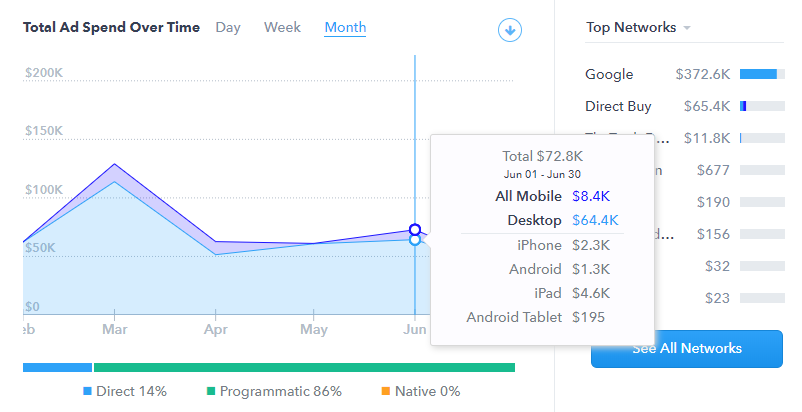
By advertising on Google, Final Fantasy XIV is able to take advantage of the different ad types Google Ads offers and reach as many users in their target audience as possible. For example, Final Fantasy XIV can use Google display ads so that ads show up on sites their target audience spends time on. So if a user Googles “the best MMO games,” relevant Final Fantasy XIV ads will appear on review sites like GamesRadar and PC Gamer.
Notice Google also lists the top games at the top of the search engine results page (SERP). These aren’t ads but the fact that Final Fantasy XIV is listed puts it in front of users.
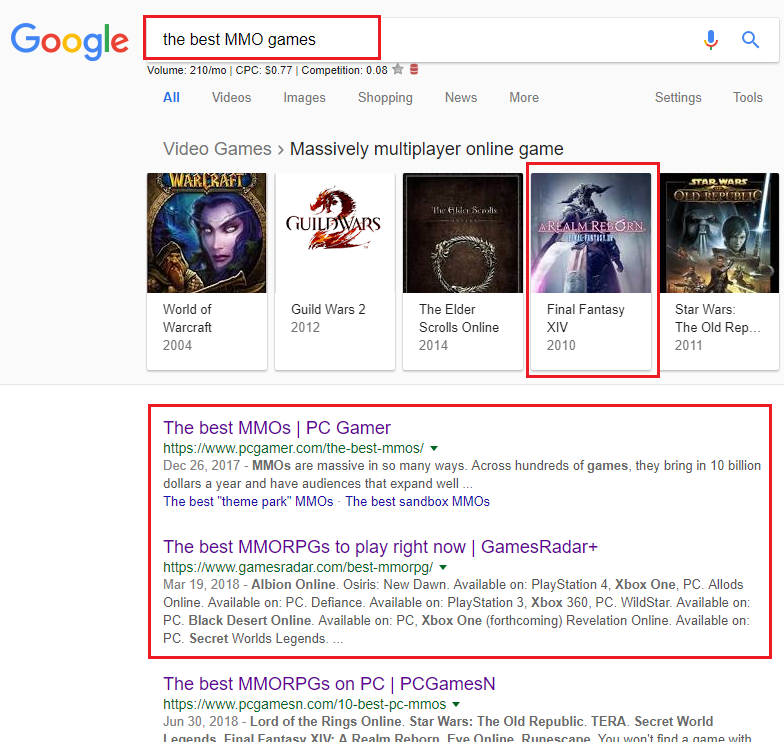
Most of the ad spend is on desktop, which makes sense considering the game is played on desktop. When a new user sees an ad, it’s easy for them to get started because they don’t have to switch devices. They just create an account, set up their profile and they’re ready to play.
Direct buy is used to a lesser extent, but by buying traffic, this gets Final Fantasy XIV in front of relevant audiences, which increases the chance of converting more people.
Publishers
Even though the MMO demographic — millennial males — spends hours a day on mobile devices, Final Fantasy XIV only adds publishers on desktop. In June they added 179 new publishers to desktop and one to mobile.
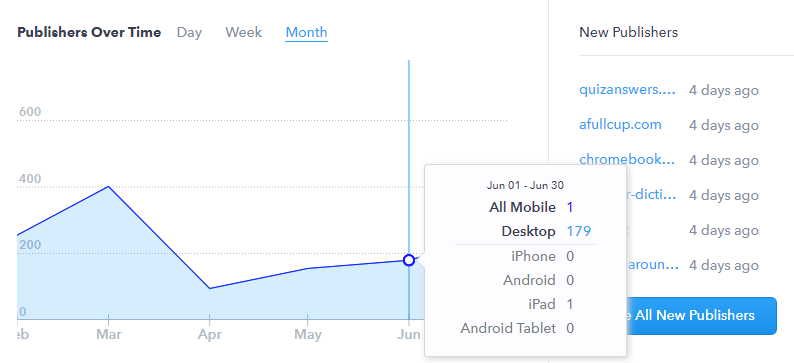
Some of the publishers Final Fantasy XIV spends most of their advertising budget on include Gamepedia, Rotten Tomatoes and Fandango.
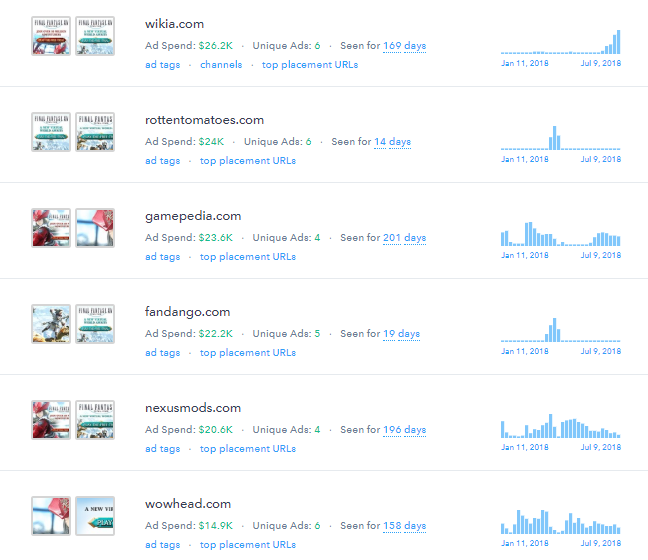
Rotten Tomatoes is an interesting choice given that it’s known mostly for its movie and TV show reviews. However, there have been five Final Fantasy movies and three TV shows. Therefore, people searching for reviews of these movies are more likely to be interested in the game series than people searching in other movie genres.
Creative
Almost all of the ads are image-based. The game itself is beautifully designed, so one way to pique new user interest is to use ads to highlight the dramatic design of the game. This gives new users an idea of what to expect and gets them interested in exploring the game for themselves.

All standard desktop ads use social proof to encourage new users to join. They use copy that says “Join over 10 million adventurers,” which speaks to how popular the game series has become. To avoid the fear of missing out (FOMO), users already interested in the game are more likely to go ahead and try it.

The calls to action (CTAs) for all ads — standard and native — say “Play the free trial.” This approach hooks new users because they get to experience the game for free before buying the full version.
Landing pages
The landing pages for these ads are a hub of information. The value the game offers — vivid design, a compelling story and an engaging user experience — is discussed throughout the landing page as a way to inform and excite users so that they sign up to play the game.
The first CTA — sign up now— is the first thing leads see on the landing page because it appears above the fold:

Leads also get an overview of the features within the game and then a video showing the game in action as they scroll down the landing page:
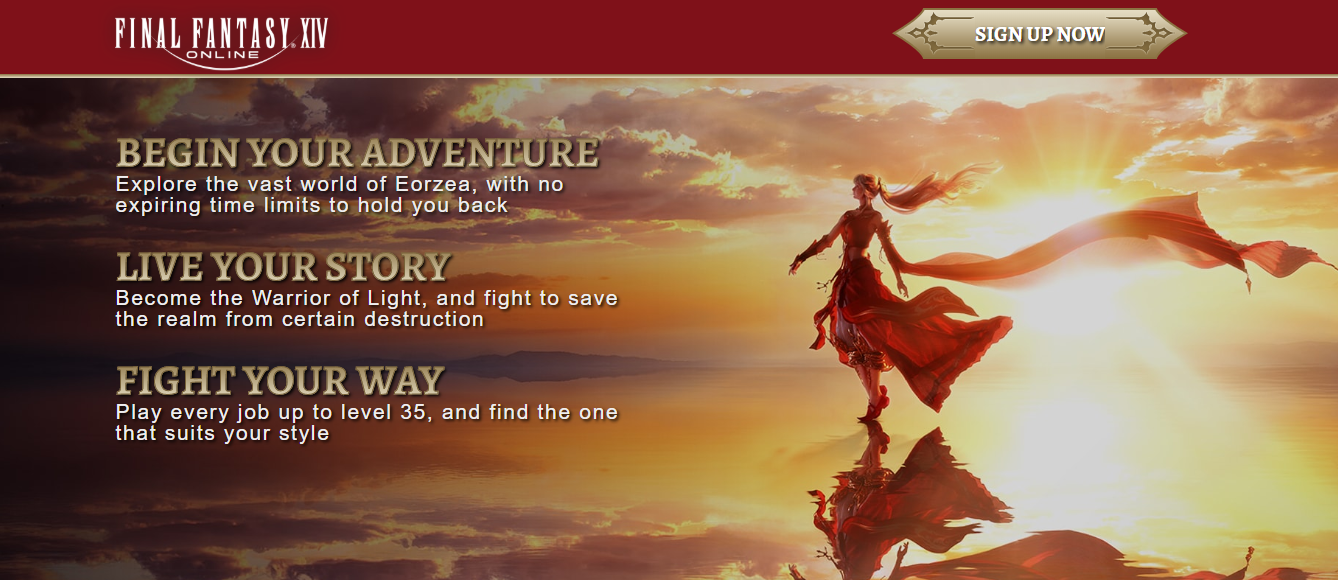

Interestingly, there’s only one CTA on this page. The original “sign up now” CTA that was initially above the fold pins to the top of the page when leads scroll down the page.
Lumosity
Lumosity is a different kind of gaming experience in that games are scientifically designed to boost user memory, information processing speed and more. This game falls into a new browser-based gaming category known as “brain games.” These games aren’t purely designed for entertainment; they’re meant to improve users’cognitive functions at the same time.
Lumosity launched in 2005 and has grown to include over 50 million users. Part of their success attracting so many users is their commitment to showing users the research and science behind the games. This gives the games credibility and builds customer trust in the product because the benefits are based on third-party data.
Lumosity also tracks user progress as they play to show them how much they’ve improved over time.
Ad spend and ad network
Lumosity’s ad network spend totals roughly $775,000 with most of that going towards AppNexus and Google.
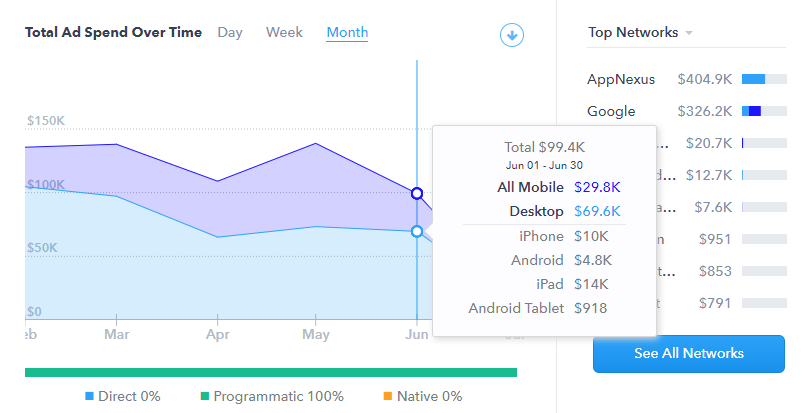
Most of their ad spend is on desktop ads. In June, Lumosity spent about $69,600 on desktop and $29,800 on mobile. Even though Lumosity also has a mobile app, the idea is that users get the best results when they devote more attention to the games vs. playing anywhere at anytime when their attention is divided — like while they’re in transit, waiting in line or at an event.
AppNexus uses “machine learning to deliver better outcomes for advertisers.” AppNexus has a “Customizable DSP” that helps Lumosity serve up ads to the exact people they want to target. Note: Lumosity only uses AppNexus to run ads on desktop as a way to target their specific audience.
When Lumosity first launched, they thought that baby boomers would be their biggest market, but millennials have proven to be the heaviest users. So ads appear in places where millennials spend the most time online. We’ll explore this idea more later.
Publishers
Since most of Lumosity’s advertising spend is on desktop, that’s where they add the most publishers over time. In June, Lumosity added 37 new publishers to desktop and only two on mobile.
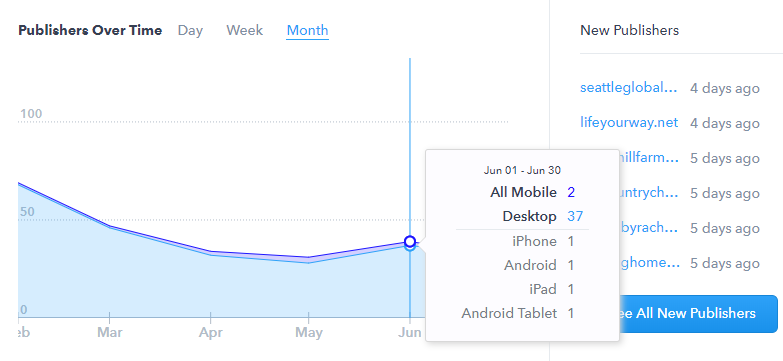 Some of the publishers Lumosity uses include The New York Times, Coolmath Games, Britannica and Merriam-Webster sites. People using these sites are looking for ways to learn more and Lumosity advertising here positions them as the tool to help readers understand and apply what they’re reading to real life much quicker.
Some of the publishers Lumosity uses include The New York Times, Coolmath Games, Britannica and Merriam-Webster sites. People using these sites are looking for ways to learn more and Lumosity advertising here positions them as the tool to help readers understand and apply what they’re reading to real life much quicker.
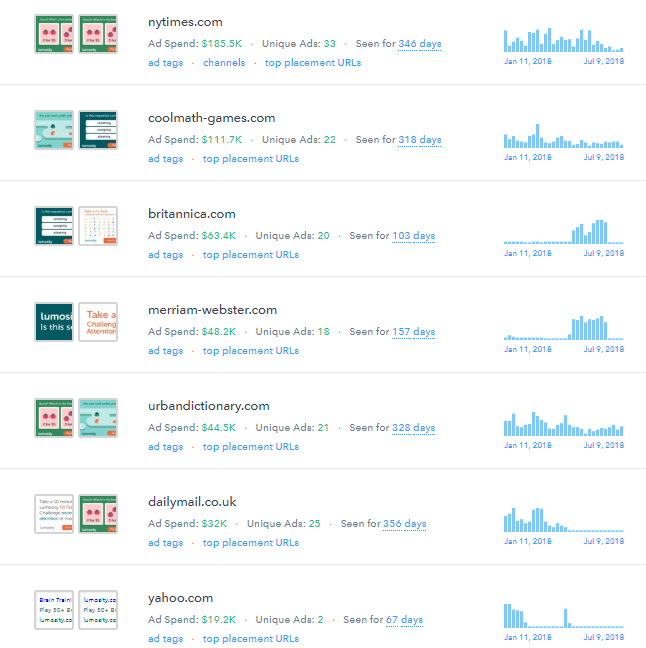
Interesting note, Lumosity has spent over $185,000 on ads appearing in the New York Times, which is much more than it’s spent on any other publisher. This speaks to Lumosity’s ability to find the places where their target audience spends time and put as much advertising in front of them as possible.
Creative
94% of Lumosity’s ads are image-based:

This is because their ads are served up as mini-games designed to entice leads to click and convert. Lumosity calls these mini-games “fit tests” because your brain is like a muscle that you have to work out and gauge its fitness level before starting a customized workout program.
The CTAs for their ads are some variation of “Play Now” or “Play Another.” These CTAs get leads to either try a game or keep testing the product before they commit to buying it.

Lumosity also uses text and text/image ads. Text ads, for example, are used for search ads using Google’s ad network. So when users search terms like “brain training games,” text ads like the one below appear in Google’s search results.
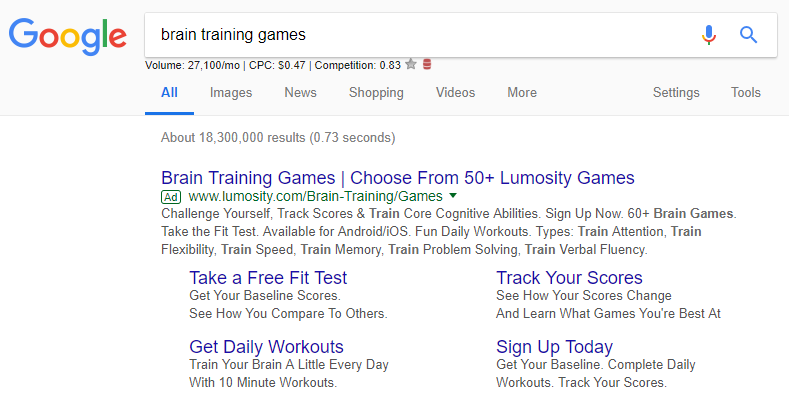
Landing pages
All of Lumosity’s landing pages follow a similar format:
- The value proposition appears first, front and center for leads to see when they open the page.
- There’s a CTA immediately underneath the value proposition.
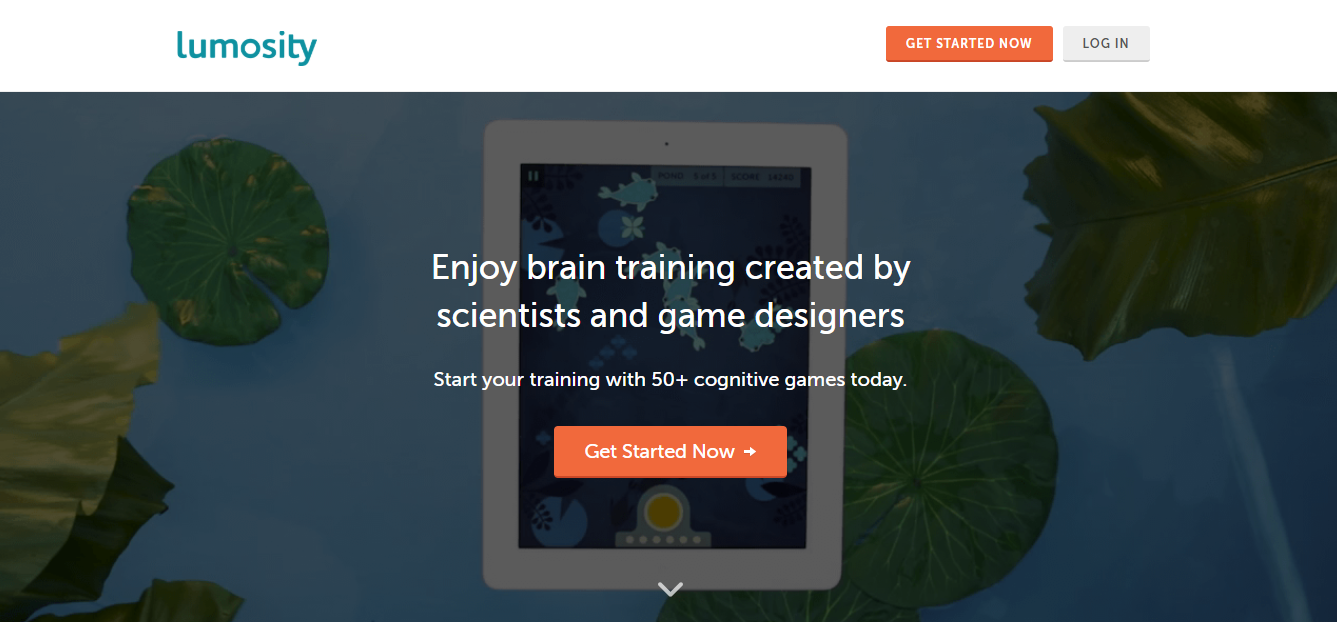
There are multiple sections below this that guide leads to conversion. For example, there are sections on how the program works, the benefits of regular training and information about the science behind the tests — there are over 50 tests for users to play.
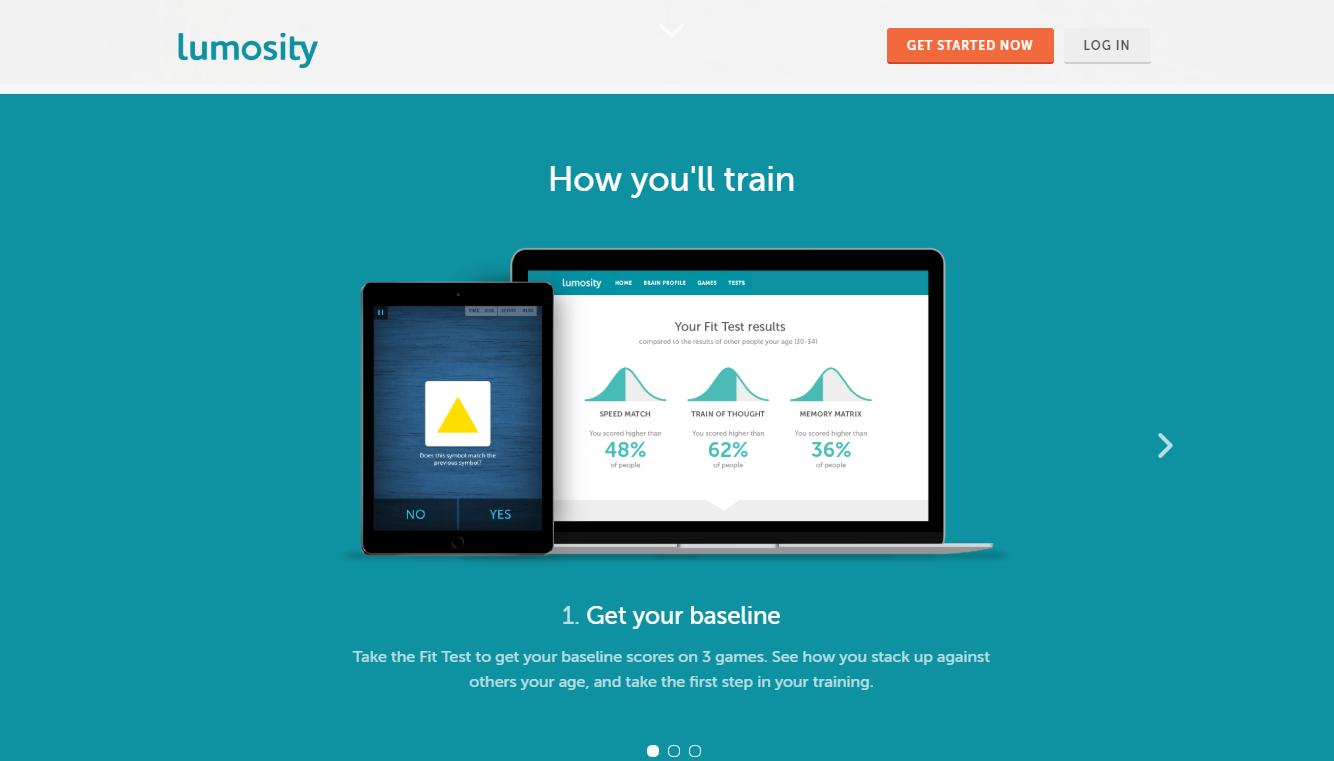
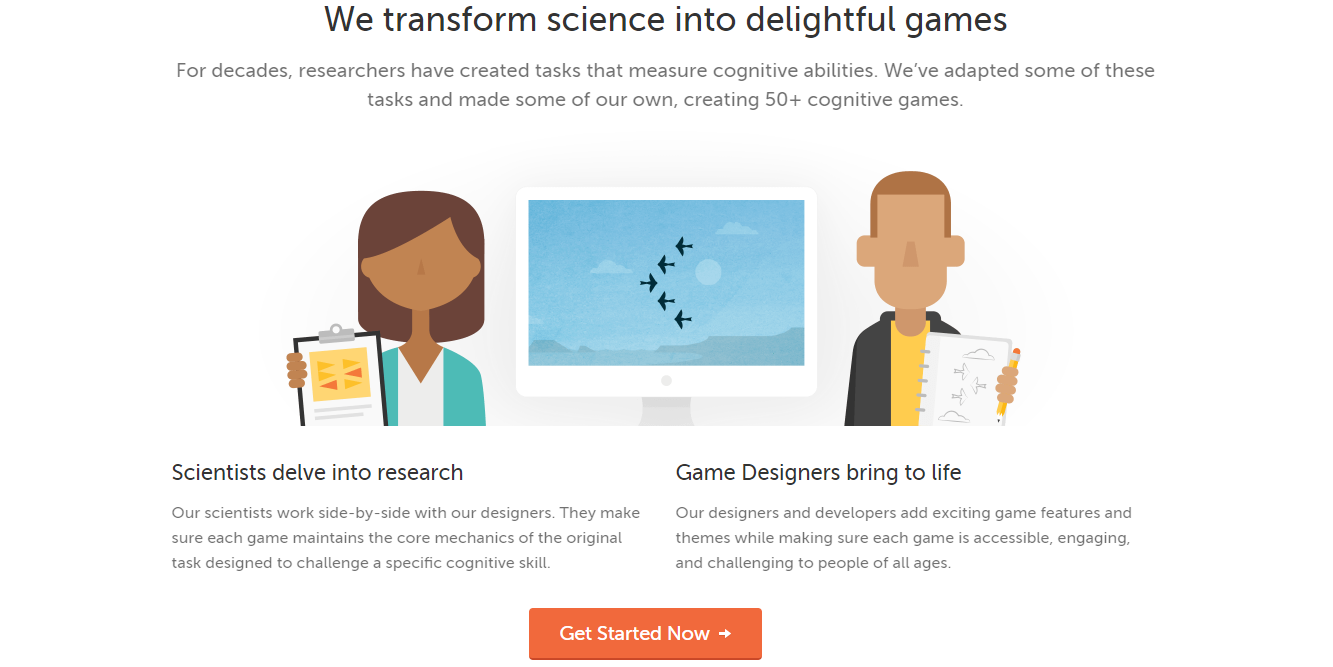

Publishers Clearing House
You might remember Publishers Clearing House’s (PCH) popular door-to-door sweepstakes from a few years ago. Since then PCH has become a billion-dollar enterprise. Part of that growth was to expand into the world of online gaming and gambling, which includes free online sweepstakes. PCH is similar to gambling and casino sites in that winning depends on how many people enter to win the jackpot.
Unlike other gaming sites, PCH doesn’t cater to a specific demographic. For example, anyone over 18 years old can take part in the sweepstakes, which means that PCH has a sizable audience to target. This is why digital advertising helps PCH get in front of as many people as possible.
Ad spend and ad network
PCH spends $10 million on ad networks with more than half of their ad spend going towards Revcontent and Google. In June they spent $1.2 million advertising on mobile and $105,600 on desktop. With mobile phone users estimated to reach 4.68 billion by 2019, it makes sense for PCH to invest so much in mobile advertising to stretch its ads reach.
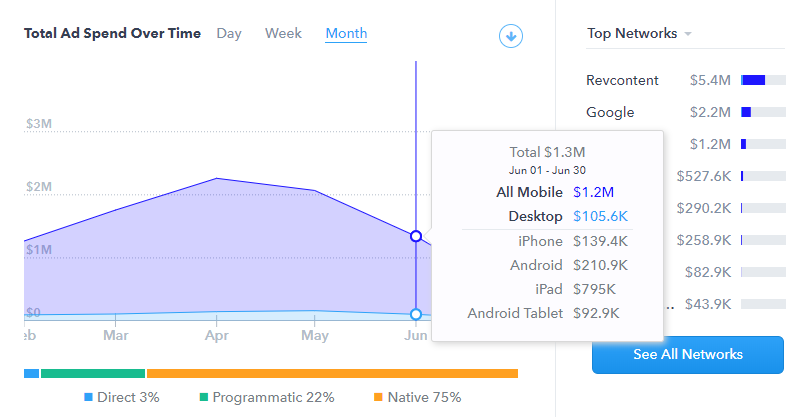
Revcontent is a content discovery network, so ads appear as recommended content on websites related to PCH’s content and games. Here’s an example of what the placement for a PCH ad looks like with Revcontent:

[Source]
Content discovery combined with Google’s ad network gets PCH in front of people based on where they spend time online and what they search for online. Remember, PCH has a fairly large audience, and these networks combined help get their ads seen.
Publishers
PCH adds about the same number of publishers to mobile and desktop at the same rate every month. In June they added 233 publishers on desktop and 244 on mobile. In addition to the ad networks they use, adding the same number of publishers to each ensure maximum exposure regardless of where their target audience is and what devices they use.
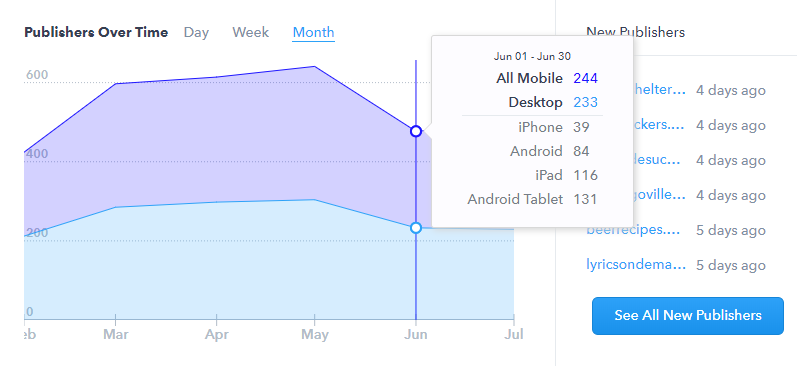
PCH also uses a wide range of publishers such as Opposing Views, GSN, Mommypage, and Faithit to appeal to a wide demographic.

Creative
64% of ads are image and text-based with ads showing leads details like how much they can win by playing.
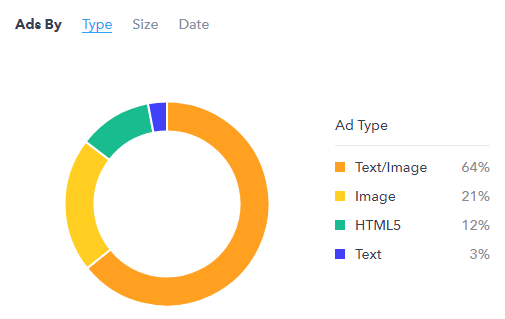

The CTAs for mobile ads are either “Play Now” or “Enter Now.” Some desktop text/image ads also show lifestyle images of people living the type of life you would expect after winning a sweepstakes. Images of large houses act as incentives to get PCH’s audience to participate in the draw.

Landing pages

Standard mobile and desktop ads include a lead generation form with a large CTA button at the bottom of the page.
Native mobile and desktop ads take leads to a sign-up page on the website where they can register to play. When leads click on the CTA, they’re also taken to the lead generation form.


Both landing pages highlight the value of the sweepstakes and keep the lead form short so that new users can get started as quickly as possible. CTAs on landing pages vary from “Submit Entry” to “Begin” to “Continue.”
Key Takeaways
There are many kinds of gaming sites available but what’s made them successful is their ability to cater their advertising strategy to the needs and expectations of their audience. By putting their audience’s needs first, instead of just trying to sell a product, these three gaming sites have seen tremendous growth and longevity over the years.
Here are a few key lessons from these sites as you choose the best networks to run your ad campaigns on.
Don’t rely on only the “popular” networks. You have a better chance of attracting “the right” users if you use networks that get you in front of specific audiences. Smaller networks can get you quality traffic when you understand your audience’s behaviors and where they spend time online.
Depending on your product type and user demographics, focus on one platform. If your product is web-based, then target desktop users so that it’s easy for them to click the ad and get started. Mobile and desktop have their unique benefits, but your focus should be to advertise where your audience spends time and are more likely to see your ad.
Use unique CTAs. Use terms that are in-line with what you’re trying to get leads to do. Gaming sites often use “Play Now” and “Enter Now” to tie into the fact that leads are about to play a game.